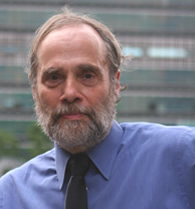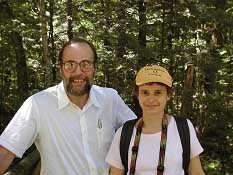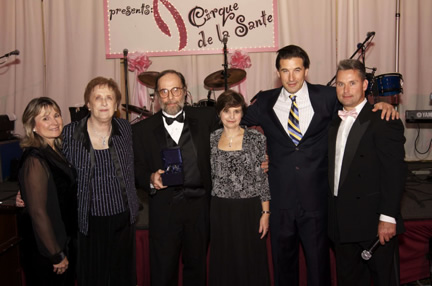Paul M. Bingham
 Associate Professor
Associate Professor
Department of Biochemistry and Cell Biology
450 Life Sciences Building
Stony Brook University
Stony Brook, NY 11794-5215
Phone: 631-632-8548
E-mail: paul.bingham@stonybrook.edu
- Research Description
After completing a PhD in Biochemistry and Molecular Biology at Harvard in 1980, Paul spent two years at the NIH branch in Research Triangle Park before jointing the faculty of the School of Medicine at Stony Brook University where he has worked for the last 29 years. Paul’s research interests are diverse. His early work focused on metazoan molecular genetics. Among his many contributions are discovery of the P element transposon (in collaboration with Margaret Kidwell and Gerry Rubin; Bingham, et al., 1982), development of the P element transposon tagging cloning strategy (in collaboration with Arno Greenleaf; Searles, et al., 1982) discovery of novel mechanisms of transcriptional enhancer function (in collaboration with Zuzana Zachar; Bingham and Zachar, 1985), discovery of novel forms of post-transcriptional regulation (in collaboration with Tze-bin Chou, Zuzana Zachar and Debbie Spikes; Chou, et al., 1987; Zachar, et al., 1987; Spikes, et al., 1994) and discovery of fundamental mechanisms of intra-nuclear molecular transport (in collaboration with Joe Kramer and Zuzana Zachar; Zachar, et al., 1993).
In recognition of his diverse research and service contributions, Paul received an honorary doctorate from his alma mater, Blackburn College, in May of 2006.
More recently Paul’s research has focused on two areas.
 First, in collaboration with Prof. Zuzana Zachar (shown at right), Paul has been pursuing
a novel approach to cancer chemotherapy. This approach exploits the now-well-characterized
differences in patterns of energy metabolism between tumor cells and normal.. Lipoic
acid is both a catalytic component of the two enzymes through which most carbon enters
tumor cell mitochondria and the source of regulatory signals that control this carbon
flux and tumor cell mitochondrial metabolism more generally. These regulatory signals
and their targets are apparently so extensively different in tumor and normal cells
that properly designed lipoate analogs – mis-informing these regualtory processes
- can be used to selectively kill tumor cells.
First, in collaboration with Prof. Zuzana Zachar (shown at right), Paul has been pursuing
a novel approach to cancer chemotherapy. This approach exploits the now-well-characterized
differences in patterns of energy metabolism between tumor cells and normal.. Lipoic
acid is both a catalytic component of the two enzymes through which most carbon enters
tumor cell mitochondria and the source of regulatory signals that control this carbon
flux and tumor cell mitochondrial metabolism more generally. These regulatory signals
and their targets are apparently so extensively different in tumor and normal cells
that properly designed lipoate analogs – mis-informing these regualtory processes
- can be used to selectively kill tumor cells.The crucial feature of this approach is that it apparently allows the killing of tumor cells without killing growing normal cells in vivo. The therapeutic index of these lipoate analog drugs in human tumor animal models can be as high as several orders of magnitude as a result of these properties. This is essentially unprecedented among cancer chemotherapeutic agents. Virtually all chemotherapeutic approaches currently in wide use kill normal cells with appreciable frequency – resulting in side-effect toxicity that is often quite severe (occassionally even fatal).
This approach was developed by Zuzana and Paul in the late 1990’s and the University holds a patent on these agents. An exclusive, world-wide liscense has been taken on this patent by Cornerstone Pharmaceuticals. Zuzana and Paul are working with the outstanding clinical, regulatory and drug development experts at Cornerstone to bring this approach into human clinical trials, currently in PhaseI/II (see http://vimeo.com/23839299 for a brief video summary of this work).
In recognition of their research contributions Paul and Zuzana received the Michael Maffetone Award for Cancer Research by the Carol M. Baldwin Breast Cancer Research Fund in the Fall of 2008 (see picture below from the award ceremony; Pictured, from left, are: Dawn Maffetone, Carol M. Baldwin, Paul, Zuzana, Billy Baldwin, and John Stoerback, Board President, Carol M. Baldwin Research Fund).

Second, Paul has developed a fundamentally new theory of the origin of humans as a unique species with diverse, unprecedented properties (Bingham, 1999 and 2000). This novel approach has subsequently been extensively developed in collaboration with economist Daijiro Okada (Okada and Bingham, 2008) and pschologist/biologist Joanne Souza (Bingham and Souza, 2009, 2011)(see pictures of Joanne and Daijiro on next page). This theory proposes that unique human properties (includuing complex language, large brains and cognitive virtuosity, complex ethical/political psychology and vast ecological dominance) are all results or features of a single, underlying adaptation – vastly expanded, unprecedented social cooperation independent of close genetic kinship.
Moreover, this unique social behavior, in turn, has a single, simple underlying cause – unprecedented access to inexpensive coercion (and coercive threat). This novel capacity makes “law enforcement” a coherent Darwinian adaptation only in humans among all terrestrial animals. This unique access to coercion initially developed through the evolution of the uniquely human capacity for elite aimed throwing in the first proto-human around two million years ago. As a result, humans have a two million year history of exquisite adaptation to the use of coercion to sustain vast, productive social cooperation. As we humans have developed ever newer coercive technologies we have continued to deploy them to sustain this cooperation on ever larger scales.
This theory is unprecedented in its simplicity, on the one hand, and its predictive power, on the other. These features, collectively, constitute parsimony – a property of all strong, useful theories.
This theory has unprecendent power to predict all the diverse features of the fossil record of human origins (including the recent, exciting findings emerging from the Dmanisi dig in former Soviet Republic of Georgia and from the newly discovered potential proto-human transitional species Australopithcus sideba in South Africa) and the origin and details of individual human properties (including language, brain expansion, cognitive virtuosity and sexual/child-rearing behaviors). Moreover, this approach inevitably contains within it the most powerful theory of history we have ever possessed – able to predict the salient details of the behaviorally modern human revolution, the agricultural revolutions and the rise of the archaic and modern states, for example. Each of these historic transitions is predicted to result from expansion of the scale of the ancient human social adaptation in consequence of development of coercive technologies of new scale. These new coercive technologies allow the management of the ancient universal non-kin conflict of interest problem on new scales. The resulting increases in social scale produce corresponding increases in the fruits of human social cooperation, for example, agricultural revolutons, the modern economic miracle and the Scientific Revolution. See www.deathfromadistance.com main page and Beyond the Book button for additional information and video lectures on the theory and this research project.
Paul and collaborator, Joanne Souza, have recently published a book-length treartment of the diverse implications of the theory (Bingham and Souza, 2009, 2011).
- Current Teaching and Services
Paul’s theoretical work on human origins, properties and history have lead to a variety of ongoing educational projects.
 First, in collaboration with Joanne Souza (right), Paul developed and teaches a large,
successful course on biological theories of human origins, properties and history
(BIO358; see course button at www.deathfromadistance.com). Our approach to the course has taken on a new level of sophistication as we have
expanded our pedgogical and technical capabilities, on pace with the evocative, important
course content. This course is a vigorous, exciting exploration of the crucial issues
in this area. Students emerge with an entirely new perspective on themselves and on
what it means (and has meant) to be human.
First, in collaboration with Joanne Souza (right), Paul developed and teaches a large,
successful course on biological theories of human origins, properties and history
(BIO358; see course button at www.deathfromadistance.com). Our approach to the course has taken on a new level of sophistication as we have
expanded our pedgogical and technical capabilities, on pace with the evocative, important
course content. This course is a vigorous, exciting exploration of the crucial issues
in this area. Students emerge with an entirely new perspective on themselves and on
what it means (and has meant) to be human.Second, in collaboration with Professor Souza, Paul has developed a state-of-the-art online version of his course on theories of human evolution (BIO358; above). This online course has being been offered to Stony Brook students since 2008. This is an exciting experiment with great potential to enrich the educational experiences of our students. We have now developed world-class expertise in online instruction. This has allowed us to grow the online course over the last several years. This effort has now expanded to encompass a graduate level version of this course (CEB553). As a purely online course CEB553 has the potential to reach state, national and even global audiences. [We have taught students in Europe and Africa to date.] This online graduate course has grown rapidly over the last several years.
Third, Paul’s longstanding belief in the crucial interconnection between high quality research and undergraduate teaching have led to a variety of further important educational projects. In addition to the human origins courses mentioned above (BIO358/CEB553), Paul served as founding Faculty Director for one of the new Undergraduate Colleges at Stony Brook – in collaboration with Joanne Souza. In building the College of Human Development Joanne and Paul initiated a number of new programs and features designed to help students (especially incoming freshman and sophomores) to access the vast opportunities presented by the large, rich faculty of this major research university. Many of these innovations persist in use today.
- Selected Publications
Paul M. Bingham - Selected Publications
Guardado Rivas, M, Stuart, S…..Zachar, Z, Bingham, PM, et al (2022). Evidence for a novel, effective approach to targeting carcinoma catabolism exploiting the first-in-class, anti-cancer mitochondrial drug, CPI-613. PLoS ONE 17: e0269620. https://doi.org/10.1371/journal.pone.0269620
Souza, J and Bingham PM (2019). The New Human Science: Sound, New Evolutionary Theory Gives Us Ultimate Causal Understanding of Human Origins, Behavior, History, Politics, and Economics. in Evolutionary Studies: Darwin’s Roadmap to the Curriculum. Oxford University Press.
Alistar, A….Bingham, PM….et al. (2017) Safety and tolerability of the first-in-class agent CPI-613 in combination with modified FOLFIRINOX in patients with metastatic pancreatic cancer: a single-centre, open-label, dose-escalation, phase 1 trial. Lancet Oncology 18, 770–78. http://dx.doi.org/10.1016/
Bingham, PM, Stuart, SD and Zachar, Z. (2014) Lipoic acid and lipoic acid analogs in cancer metabolism and chemotherapy. Expert Review of Clinical Pharmacology, 7, 837-846.
Stuart, SD, Schauble, A, Gupta, S, Kennedy, AD, Keppler, BR, Bingham, PM, Zachar, Z. (2014) A strategically designed small molecule attacks alpha-ketoglutarate dehydrogenase in tumor cells through a redox process. Cancer & Metabolism2,4.
Bingham, PM, Stuart, SD and Zachar, Z. (2014)Cancer Metabolism: A Nexus of Matter, Energy, and Reactive Oxygen Species. pgs.7-28 in Tumor Metabolome Targeting and Drug Development. eds. Steven Kanner (Arrowhead Research) and Beverly A. Teicher (NCI). Springer, New York.
Souza, J. & Bingham P. M. (2014). Disciplinary unification of the Natural Sciences, the Humanities, and the Social Sciences: Adapted minds and strategic approaches to consilience in the Academy. EvoS Journal: The Journal of the Evolutionary Studies Consortium, 6(1), 51-62.
http://evostudies.org/wp-content/uploads/2014/01/Souza-Bingham_Vol6Iss1.pdf
Bingham PM, Souza J. (2013). Theory Testing in Prehistoric North America: Fruits of One of the World's Great Archeological Natural Laboratories. Evolutionary Anthropology. 22,145-53.
Bingham PM, Souza J, Blitz JH. (2013). Social Complexity and the Bow in the Prehistoric North American Record. Evolutionary Anthropology 22, 81-8.
Bingham, P.M. and Zachar, Z. (2012). The pyruvate dehydrogenase complex in cancer: Implications for the transformed state and cancer chemotherapy. Chapter 3 In: Dehydrogenases Canuto, RA ed. InTech Press
Zachar, Z, Marecek, J, Maturo, C., Gupta, S, Stuart S.D., Howell, K., Schauble, A., Lem, A., Piramzadian, A., Karnik, S., Lee, K., Rodriguez, R., Shorr, R. and Bingham, P.M. (2011). Non-redox-active lipoate derivates disrupt cancer cell mitochondrial metabolism and are potent anticancer agents in vivo. Journal of Molecular Medicine 89,1137-1148. DOI 10.1007/s00109-011-0785-8
Bingham P.M. and Souza, J. (2011). Death from a distance and the birth of the humane universe: Human evolution, history and your future. KINDLE EDTION. BookSurge, South Carolina
Bingham P.M. and Souza, J. (2009). Death from a distance and the birth of the humane universe: Human evolution, history and your future. BookSurge, South Carolina.
Bingham, PM, (2009). On the evolution of language: implications of a new and general theory of human origins, properties and history in: Larson, RK, Deprez, V, and Yamakido, H, (Eds.), The Evolution of Human Language: Biolinguistic Perspectives, Cambridge University Press., Cambridge, UK.
Okada, D. and Bingham, P.M. (2008). Human uniqueness - self-interest and social cooperation. Journal of Theoretical Biology 253, 261– 270
Bingham, P. M. (2000). Human evolution and human history: A complete theory. Evolutionary Anthropology 9, 248-257.
Bingham, P. M. (1999). Human uniqueness: A general theory. Quarterly Review of Biology 74,133-169.
Bingham, P. M. (1997). "Cosuppression comes to the animals." Cell 90, 385-387.
Spikes, D. A., J. Kramer,….P.M. Bingham. (1994). SWAP Pre-Messenger-RNA Splicing Regulators Are a Novel, Ancient Protein Family Sharing a Highly Conserved Sequence Motif with the Prp21 Family of Constitutive Splicing Proteins. Nucleic Acids Research 22, 4510-4519.
Kramer, J., Zachar, Z., Bingham, PM. (1994). Nuclear pre-mRNA metabolism: channels and tracks. Trends in Cell Biology 4, 35–37.
Zachar, Z., T. B. Chou…P.M. Bingham (1994). Analysis of Autoregulation at the Level of Pre-Messenger-RNA Splicing of the Suppressor-of-White-Apricot Gene in Drosophila. Genetics 137,139-150.
Zachar, Z., J. Kramer, …P.M. Bingham (1993). Evidence for Channeled Diffusion of Pre-messenger RNAs During Nuclear-RNA Transport in Metazoans. Journal of Cell Biology 121, 729-742.
Spikes, D. and P. M. Bingham (1992). Analysis of Spliceosome Assembly and the Structure of a Regulated Intron in Drosophila Invitro Splicing Extracts. Nucleic Acids Research 20, 5719-5727.
Li, H. and P. M. Bingham (1991). Arginine Serine-Rich Domains of the su(wa) and tra RNA Processing Regulators Target Proteins to a Subnuclear Compartment Implicated in Splicing. Cell 67, 335-342.
Zachar, Z. and P. M. Bingham (1989). Suppressible Insertion-Induced Mutations in Drosophila. Progress in Nucleic Acid Research and Molecular Biology 36: 87-98.
Bingham, P. M., T. B. Chou, Z. Zachar et al. (1988). On Off Regulation of Gene-Expression at the Level of Splicing. Trends in Genetics 4, 134-138.
Chou, T. B., Z. Z. Zachar, …P.M. Bingham. (1987). Developmental Expression of a Regulatory Gene Is Programmed at the Level of Splicing. EMBO Journal 6, 4095-4104.
Zachar, Z. Z., T. B. Chou, P.M. Bingham et al. (1987). Evidence That a Regulatory Gene Autoregulates Splicing of Its Transcript. EMBO Journal 6, 4105-4111.
Zachar, Z., D. Garza, et al. (1987). Molecular-Cloning and Genetic-Analysis of the suppressor-of-white-apricot Locus from Drosophila melanogaster. Molecular and Cellular Biology 7, 2498-2505.
Bingham, P. M. and C. H. Chapman (1986). Evidence That white-blood Is a Novel Type of Temperature-Sensitive Mutation Resulting from Temperature-Dependent Effects of a Transposon Insertion on Formation of White Transcripts. EMBO Journal 5, 3343-3351.
Zachar, Z., C. H. Chapman, ………P.M. Bingham. (1985). On the Molecular Basis of Transvection Effects and the Regulation of Transcription. Cold Spring Harbor Symposia on Quantitative Biology 50, 337-346.
Zachar, Z., D. Davison…P.M. Bingham. (1985). A Detailed Developmental and Structural Study of the Transcriptional Effects of Insertion of the copia Transposon into the white Locus of Drosophila melanogaster. Genetics 111, 495-515.
Davison, D., C. H. Chapman,…….. P.M. Bingham (1985). Genetic and Physical Studies of a Portion of the White Locus Participating in Transcriptional Regulation and in Synapsis-Dependent Interactions in Drosophila Adult Tissues. Genetics 110, 479-494.
Bingham, P. M. and Z. Zachar (1985). Evidence That 2 Mutations, wDZL and z1, Affecting Synapsis-Dependent Genetic Behavior of white, Are Transcriptional Regulatory Mutations. Cell 40, 819-825.
Ginzburg, L. R., P. M. Bingham, et al. (1984). On the Theory of Speciation Induced by Transposable Elements. Genetics 107, 331-341.
Searles, L. L., R. S. Jokerst,…P.M. Bingham…et al. (1982). Molecular-Cloning of Sequences from a Drosophila RNA Polymerase-II Locus by P-Element Transposon Tagging. Cell 31, 585-592.
Zachar, Z. and P. M. Bingham (1982). Regulation of white Locus Expression - the Structure of Mutant Alleles at the white Locus of Drosophila melanogaster. Cell 30, 529-541.
Rubin, G. M., M. G. Kidwell, P.M. Bingham. (1982). The Molecular-Basis of P-M Hybrid Dysgenesis - the Nature of Induced Mutations. Cell 29, 987-994.
Bingham, P. M., M. G. Kidwell and G.M. Rubin. (1982). "The Molecular-Basis of P-M Hybrid Dysgenesis - the Role of the P-Element, a P-Strain-Specific Transposon Family." Cell 29, 995-1004.
Bingham, P. M. (1980). A Novel Dominant Mutant Allele at the white Locus of Drosophila melanogaster Is Mutable." Cold Spring Harbor Symposia on Quantitative Biology 45: 519-525.
Bingham, P. M., R. Levis, G.M. Rubin. (1981). Cloning of DNA-Sequences from the White Locus of Drosophila-Melanogaster by a Novel and General-Method. Cell 25, 693-704.
Bingham, P. M. and B. H. Judd (1981). A Copy of the copia Transposable Element Is Very Tightly Linked to the wa Allele at the white Locus of Drosophila melanogaster. Cell 25. 705-711.
Bingham, P. M. (1980). The Regulation of White Locus Expression - a Dominant Mutant Allele at the white Locus of Drosophila melanogaster." Genetics 95, 341-353.
Wu, C., P. M. Bingham, et al. (1979). Chromatin Structure of Specific Genes .1. Evidence for Higher-Order Domains of Defined DNA-Sequence. Cell 16, 797-806.
Bingham, P. M., R. H. Baltz, et al. (1976). Heat Mutagenesis in Bacteriophage-T4 - Transversion Pathway. Proceedings of the National Academy of Sciences of the United States of America 73, 4159-4163.
- Education, Employment and Selected Honors
- 1973 - BA, Biology Blackburn College
- 1975 - MS, Microbiology University of Illinois
- 1980 - PhD, Biochemistry and Molecular Biology, Harvard University
- 1980 - 1982 Staff Fellow
Laboratory of Genetics, NIEHS, Research Triangle Park, NC - 1982 - 1988 Assistant Professor, Department of Biochemistry
State University of New York, Stony Brook, NY - 1988 - present Associate Professor, Department of Biochemistry & Cell Biology
State University of New York, Stony Brook, NY - 2006 Honorary doctorate, Blackburn College
- Invited Lectures
- Morris Symposium on Language Evolution
- Leakey Symposium on Human Evolution
- “Biology of Economics and Economics of Biology”, Stony Brook Economics Department
- Montauk Risk Assessment Conference
- Blackburn College Commencement Address
- “Implications of a new theory of human evolution for science, medicine and the human future” with Joanne Souza, Pathology, Stony Brook
- “Thioctans, a novel class of anti-cancer agents” Pfizer Pharmaceuticals
- “Thioctans, a novel class of anti-cancer agents” Roche Pharmaceuticals
- “Thioctans, a novel class of anti-cancer agents” CBI Clinical conference
- “How natural selection produced humans, how humans produce knowledge” with Joanne Souza SUNY New Paltz (see video athttp://mediasite.suny.edu/mediasite/SilverlightPlayer/Default.aspx?peid=6299edf081154360b207a0b59217250f)
- “Unique power of the North American record allows tests of a new theory of social evolution” Society for American Archaeology, Sacramento (see lecture video athttp://www.deathfromadistance.com/newsevents.php#04-18-11-ssa)
- Radio interview with Prof. Marshall Poe on his series “New Books in History”
